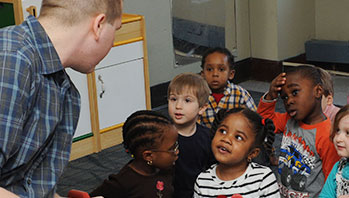- clear plastic cup
- pitcher of water
- “Places to Pour Water” chart
- “What We Know About Water” chart
- absorb
- flow
- river
- stream
MA Standards:
Speaking and Listening/SL.PK.MA.1: Participate in collaborative conversations with diverse partners during daily routines and play.
Language/L.PK.MA.6: Use words and phrases acquired through conversations, listening to books read aloud, activities, and play.
Head Start Outcomes:
Language Development/Receptive Language: Attends to language during conversations, songs, stories, or other learning experiences.
Language Development/Expressive Language: Uses language to express ideas and needs.
Logic and Reasoning/Reasoning and Problem Solving: Classifies, compares, and contrasts objects, events, and experiences.
PreK Learning Guidelines:
English Language Arts/Language 2: Participate actively in discussions, listen to the ideas of others, and ask and answer relevant questions.
Talk Together: More About Water

© Commonwealth of Massachusetts, Department of Early Education and Care (Jennifer Waddell photographer). All rights reserved.
STEM Key Concepts: Water flows downhill; Different objects can be used to move water and change its direction; Water behaves differently on different surfaces: Some surfaces absorb water, some don't
ELA Focus Skills: Listening and Speaking, Vocabulary
Invite children to share what they have been observing and learning about water. Facilitate the discussion with questions such as,
- What words can you think of to describe how water looks and moves? (wet, flow, pour, puddle)
- How does the shape of water change in different containers? (takes the shape of the container it is in)
Display the “Places to Pour Water” chart, reviewing how water behaved on different surfaces. Remind children that some surfaces absorb, or soak up, the water and other surfaces do not absorb the water. Different surfaces that absorb water absorb water differently. Ask children if they observed any “rivers” of water during their explorations. Say that sometimes when you pour water on a surface it doesn’t get absorbed, but it flows like a stream or a river. Tell children they are going to make their own streams and rivers.
